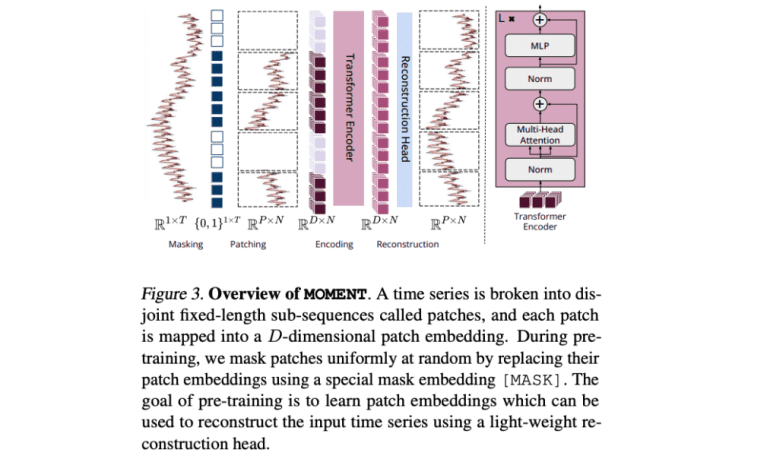- CMU researchers propose MOMENT, an open-source family of foundation models for time series analysis.
- Challenges in pre-training large models include scarcity of public time series data and lack of benchmarks.
- MOMENT leverages the Time Series Pile, combining diverse datasets for multi-dataset pretraining.
- MOMENT’s architecture comprises a transformer encoder and lightweight reconstruction head for tasks like forecasting and anomaly detection.
- Comparative studies show MOMENT competes with deep learning and statistical models, with some non-transformer-based methods outperforming.
- MOMENT offers versatility and robustness for various time series analysis tasks.
Main AI News:
In today’s dynamic data landscape, pre-training large models for time series analysis encounters numerous obstacles. Challenges range from the scarcity of comprehensive public time series datasets to the intricate nature of diverse time series characteristics. Moreover, the lack of standardized benchmarks for model assessment, particularly in scenarios with limited resources and minimal supervision, complicates progress. Nevertheless, the significance of time series analysis persists across critical domains such as weather forecasting, healthcare monitoring, and anomaly detection in software systems. While leveraging pre-trained language, vision, and video models holds promise, adapting these models to the nuances of time series data is imperative for achieving optimal results.
Transforming Time Series Analysis: Overcoming Challenges with MOMENT
The application of transformers to time series analysis introduces its own set of challenges, notably the exponential growth of the self-attention mechanism concerning input token size. However, by treating time series sub-sequences as tokens, efficiency and effectiveness in forecasting can be greatly enhanced. Enter MOMENT, a groundbreaking initiative spearheaded by researchers from Carnegie Mellon University and the University of Pennsylvania. MOMENT introduces a novel approach to address these challenges through a family of open-source foundation models tailored for general-purpose time series analysis.
Unlocking the Power of MOMENT: Revolutionizing Time Series Analysis
MOMENT leverages the Time Series Pile, a vast repository of public time series data, to confront the unique challenges inherent in time series analysis. By amalgamating datasets from various sources, MOMENT mitigates the scarcity of comprehensive time series datasets, offering a rich resource for large-scale multi-dataset pretraining. These transformer models, equipped with high capacity, are pre-trained using a masked time series prediction task on an extensive array of data spanning diverse domains. This approach ensures versatility and robustness in addressing a wide spectrum of time series analysis tasks.
Delving Deeper into MOMENT: A Blueprint for Success
At its core, MOMENT comprises a transformer encoder paired with a lightweight reconstruction head, pre-trained on a masked time series prediction task. The architecture accommodates variations of MOMENT tailored to different encoder sizes, optimized through the utilization of the Adam optimizer and gradient checkpointing for efficient memory management. MOMENT is architected to facilitate fine-tuning for downstream tasks such as forecasting, classification, anomaly detection, and imputation, either through end-to-end training or linear probing, depending on task requirements.
Navigating the Landscape: MOMENT in Comparison
A comprehensive evaluation of MOMENT against state-of-the-art deep learning and statistical machine learning models is paramount. While MOMENT diverges from TimesNet’s transformer-centric approach, it stands poised to revolutionize the field of time series analysis. Notably, statistical and non-transformer-based methods such as ARIMA for short-horizon forecasting, N-BEATS for long-horizon forecasting, and k-nearest neighbors for anomaly detection exhibit superior performance across various tasks. These findings underscore the importance of rigorous comparative analysis in gauging the practical efficacy of innovative methodologies like MOMENT.
Conclusion:
The introduction of MOMENT marks a significant advancement in time series analysis, addressing challenges of data scarcity and benchmarking. Its versatility and robustness across diverse tasks, despite facing competition from established models, signal a promising future for the market, with potential implications for sectors ranging from finance to healthcare. Businesses investing in data analytics should monitor MOMENT’s development closely to leverage its capabilities effectively.

